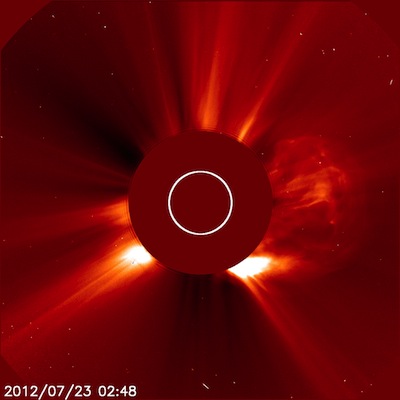
Earth's close call with a solar super storm
BY ALEX GREEN
ASTRONOMY NOW
Posted: 6 APRIL 2014

On 23 July 2012 the Sun launched a magnetic attack that only narrowly missed Earth by nine days -- a relatively close and terrifying call.
The magnetic storm sent by the Sun came from a succession of coronal mass ejections that propelled disastrous amounts of magnetised plasma through Earth's orbit. Had this solar super storm hit Earth, it would have produced the most severe geomagnetic storm since the nineteenth century.
The storm would have disrupted electrical power grids, radio communications, satellite navigation and spacecraft operations and, as estimated by the Space Study Board of the United States, the impact of such a storm on technological grounds alone could have had a worldwide cost of a trillion dollars, with a recovery time up to a decade. The severity of this storm would have been so enormous that the Internet, phone lines and all other forms of modern communication would be gone, knocking us back several years. Computers would have crashed, with some places in total darkness through the loss of power.
This cannot be said for all countries however, as it all comes down to how much a country depends on technology, says Professor Ying Liu of China's State Key Laboratory of Space Weather, who led research into the solar eruptions.
"For example, a developing country that does not depend much on technology may be affected less than those that depend heavily on such technology," he says. "On the other hand, if the technological systems are better prepared for such storms, the country may be affected less."
Based on the research that Liu and his colleagues have conducted on this particular magnetic storm, they conclude that the Sun hurled the magnetic cloud through the solar wind at a speed of more than 2,000 kilometres per second, which is around four times the speed of a normal magnetic cloud. Had Earth been in the line of fire that day, it would have felt the full impact of the storm. The resulting major power blackouts would have meant a lot of related repairs, the loss of frozen food storages and many of the world's electrical power grids, while trans-oceanic cables could have also been affected.

An image of the Sun emitting a coronal mass ejection (right) on 23 July. Image: ESA/NASA (SOHO).
Space agencies would have had to replace lost satellites and monitor the existing ones as the upper atmosphere would become so inflated by heating that it would have lead to faster satellite orbital decay in several cases.
However, as Liu's co-researcher, Janet Luhmann of the University of California, Berkeley explains, knowing when these storms are going to occur is hard to predict.
"Most solar storms, like regular weather, only give some warning and different types of space weather have different levels of predictability," she says. "For example if a big, complex sunspot group is on the centre of the Sun's disc or to the west of it, we watch it very closely for any major flares or coronal mass ejections. If these are observed, one expects high-energy particles to arrive in Earth's vicinity within a few tens of minutes and then a few days later a big geomagnetic storm is possible."
Fortunately for us, the chances of another storm similar to the one in 2012 happening again so soon are very slim, although not impossible, according to Luhmann.
"We get fairly big storms about once in every 11-year solar cycle in a specific location but this type of 'perfect storm' is fortunately a lot rarer. However, like major earthquakes, typhoons and tornadoes, there is always a chance of one at any time."
|



